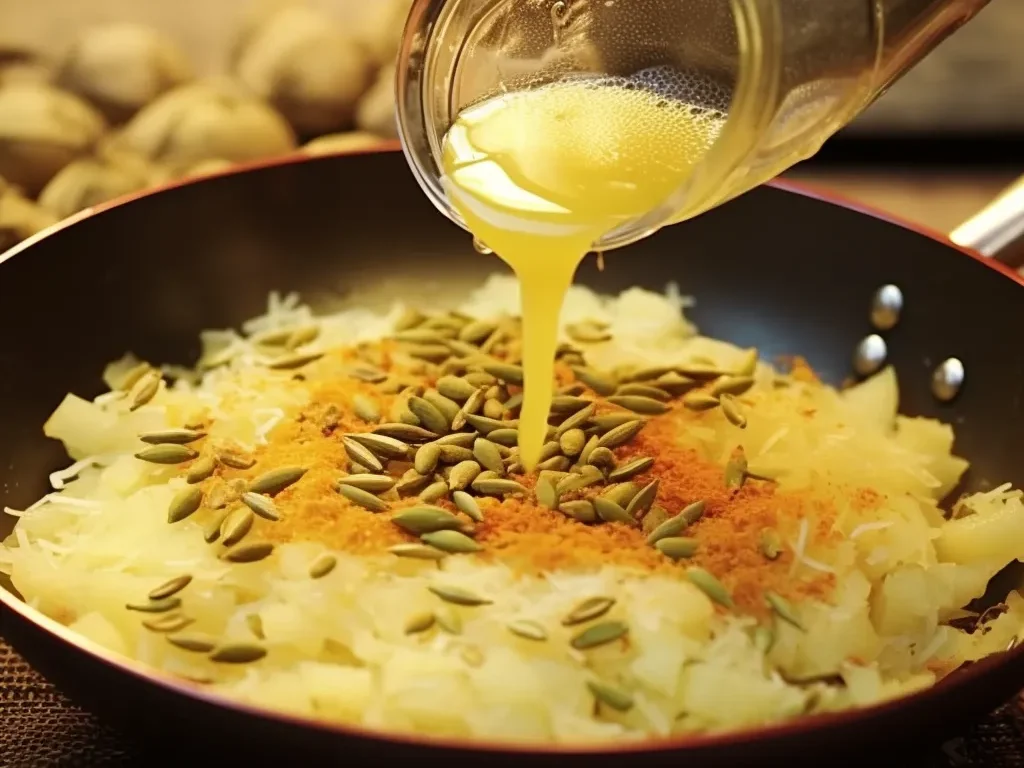Introduction to the Coal Miner’s Classic Sauerkraut Recipe
Have you ever wondered how coal miners managed to survive the long, grueling hours underground? The answer might just lie in their food—specifically, the coal miner’s recipe for sauerkraut. This humble dish has been a staple in coal mining communities for generations, providing nourishment and lasting health benefits. Packed with probiotics and essential nutrients, this traditional recipe isn’t just about food—it’s about strength and survival.
In this article, we’ll explore how coal miners relied on sauerkraut to fuel their demanding work. We’ll dive into the history, key ingredients, and give you step-by-step instructions to make your own batch of this hearty dish. Whether you’re new to sauerkraut or a long-time fan, you’ll find everything you need to recreate the coal miner’s recipe in your own kitchen.
The Rich History of Coal Miner’s Sauerkraut
The history of the coal miner’s recipe for sauerkraut is deeply rooted in the traditions of hardworking people. For generations, coal miners have relied on this simple, yet effective recipe to provide sustenance during long shifts in harsh conditions. Sauerkraut is not just a side dish; it’s a testament to the resilience of miners and the resourcefulness of those who needed nourishing meals that could last through the cold winter months.
What is Sauerkraut?
You may already know what sauerkraut is, but let’s break it down further. Sauerkraut is simply finely shredded cabbage that has been fermented through a natural process involving beneficial bacteria. The process not only preserves the cabbage but also enriches it with unique flavors and health benefits.
Fermentation is a method that has been around for centuries, long before refrigerators and canned goods. People realized that through the magic of fermentation, they could preserve vegetables and keep them edible for extended periods. This was especially important for people living in regions with harsh winters and limited access to fresh produce.
The Importance of Sauerkraut in Coal Miner’s Diet
For coal miners, sauerkraut wasn’t just a side dish—it was a lifesaver. The reason for its inclusion in their diet is both practical and nutritional. Let’s start with the practical side: sauerkraut is cheap to make, and once it’s fermented, it doesn’t require refrigeration. The miners could make large batches and store them in cool, dark places for months, making it an ideal food source during the long winter months when fresh vegetables were scarce.
On the nutritional side, sauerkraut provided a wealth of benefits. The cabbage used in sauerkraut is a great source of Vitamin C, which was crucial in preventing scurvy, a common affliction in the past due to the lack of fresh fruits and vegetables. Additionally, the fermentation process produces beneficial probiotics, which are known to support a healthy digestive system. This was especially important for coal miners, whose bodies were often under physical stress.
Ingredients for Coal Miner’s Sauerkraut Recipe
Now that you understand a bit about the history and significance of sauerkraut, let’s talk about the recipe itself. Making sauerkraut is simple and requires just a few basic ingredients. These ingredients might seem basic, but they come together to create a dish that’s much more than the sum of its parts.
Fresh Cabbage: The Core Ingredient
Cabbage is the star of this dish. It’s affordable, widely available, and packed with nutrients. When choosing cabbage for sauerkraut, it’s best to go for a firm, green cabbage. The cabbage should be dense and heavy for its size, which indicates freshness. The outer leaves may be a little rough, but as long as the inner cabbage is crisp and healthy, you’re good to go.
The reason cabbage works so well for sauerkraut is because of its natural sugars. When these sugars are exposed to salt, they help draw out the moisture from the cabbage, which is essential for the fermentation process.
Essential Spices and Flavorings
While the basic recipe for sauerkraut is just cabbage and salt, some variations add spices and flavorings to enhance the taste. Traditionally, coal miners might have used just salt, but in some regions, people add caraway seeds or juniper berries for a bit of flavor. Caraway seeds add a slight licorice-like flavor, while juniper berries bring a sharp, piney note to the sauerkraut.
You can experiment with these additions, but remember that the beauty of sauerkraut lies in its simplicity. The fermentation process does most of the work when it comes to flavor development.
Optional Additions: Customizing Your Sauerkraut
One of the best things about making sauerkraut is how customizable it is. While the traditional recipe remains simple, some coal miners or families might have added other ingredients based on what was available to them. Some might choose to add a bit of garlic or even grated carrots to the cabbage mixture. These additions bring new layers of flavor to the sauerkraut, and while they’re not strictly necessary, they can add a personal touch to the dish.
Block Quote:
“Sauerkraut is a dish that can be tailored to your tastes. Whether you prefer it spicier or milder, more tangy or more savory, the possibilities are endless. Don’t be afraid to get creative with your ingredients, just like the coal miners who made the recipe their own over time.”
How to Make Coal Miner’s Sauerkraut: Step-by-Step Instructions
Coal Miner’s Recipe for Sauerkraut
Recipe by Chef ALLY
This hearty and tangy sauerkraut dish, inspired by coal miner traditions, is the perfect combination of simplicity and comfort. It pairs wonderfully with your choice of protein and is a satisfying option for lunch or dinner. Made with easily accessible ingredients, this rustic recipe is both easy to make and packed with flavor.
Course: Lunch (also suitable for dinner)
Cuisine: Rustic European
Difficulty: Easy
Servings: 4 servings
Prep time: 10 minutes
Cooking time: 30 minutes
Total time: 40 minutes
Calories: 250 kcal per serving
Ingredients
- 2 cups sauerkraut (drained slightly)
- 1 medium onion, finely chopped
- 2 cloves garlic, minced
- 1 tablespoon olive oil or butter
- 1 cup vegetable or chicken broth
- 2 sausages or 1 cup of plant-based protein (e.g., tofu or tempeh)
- 1 teaspoon caraway seeds (optional)
- 2 bay leaves
- 1/2 cup apple cider or beer (optional)
- Salt and pepper, to taste
- Optional: 1 small apple, grated, or 1 tablespoon brown sugar for sweetness
Directions
1.Heat olive oil or butter in a skillet over medium heat. Add the chopped onions and garlic and sauté until golden and fragrant.

2. Add the sauerkraut to the skillet, mixing it well with the onions and garlic. Place the sausages (or plant-based protein) on top.

3. Pour in the broth and, if desired, the apple cider or beer. Season with caraway seeds, bay leaves, salt, and pepper.

4. Cover the skillet and simmer for 30 minutes, allowing the flavors to meld together.

5. For a caramelized texture, uncover the skillet for the last 10 minutes of cooking.

6. Remove the bay leaves and adjust the seasoning to taste before serving.
Notes
- If the sauerkraut is too tangy, rinse it lightly under cold water before cooking.
- Pair with mashed potatoes or crusty bread for a complete meal.
- For a vegan version, use vegetable broth and swap sausages for tempeh or tofu.
Nutritional Value (Approximate Per Serving)
- Calories: 250
- Protein: 12g
- Fat: 10g
- Carbohydrates: 20g
- Fiber: 4g
- Sodium: 800mg
Troubleshooting Common Problems
Even though making sauerkraut is a simple process, things don’t always go smoothly. Here are some common issues you might face, and how to solve them:
Problem 1: Sauerkraut Doesn’t Ferment Properly
One of the most frustrating problems is when your sauerkraut isn’t fermenting as expected. If you notice that there’s no bubbling or the cabbage looks dry after a few days, it might not be getting the right conditions. Here’s how to fix it:
- Check the temperature: Sauerkraut ferments best at a temperature of 65-70°F (18-21°C). If it’s too cold, fermentation will be slow. If it’s too hot, you risk the sauerkraut becoming too sour or even spoiling. Find a spot in your home that stays at a consistent temperature, like a pantry or basement.
- Ensure the cabbage is submerged: If the cabbage isn’t fully covered by the brine, it won’t ferment properly. If there’s not enough brine, add some salted water to cover the cabbage and make sure it’s tightly packed.
Problem 2: Sauerkraut Turns Too Sour
If your sauerkraut ends up too sour for your taste, it’s likely been left to ferment for too long. Don’t worry—this can be easily solved for next time by checking it daily and tasting it regularly. But if it’s already too sour, you can use it in dishes where the strong flavor will complement other ingredients, such as in sausages, soups, or as a topping for sandwiches.
Problem 3: Mold on the Sauerkraut
Mold is another common issue, but it’s easy to prevent. If you notice any mold forming on the surface, don’t panic. Simply scrape it off, as the rest of the sauerkraut should be fine underneath. However, to avoid mold in the future, make sure the cabbage is fully submerged in brine and that you’re fermenting it in a clean environment. You can also place a weight on top of the cabbage to help keep it submerged.
Storing Your Sauerkraut
Once your sauerkraut has fermented to your liking, it’s time to store it. While the sauerkraut can be eaten fresh, its flavor will deepen and improve over time, just like a good wine. If you plan to eat it soon, you can keep it in the fridge, where it will stay fresh for several weeks. But for longer storage, you can transfer it into smaller jars and store it in the refrigerator for up to six months.
When storing sauerkraut, make sure that it remains submerged in its brine. If you’ve made a large batch, you can use a fermentation lid or an airtight jar to keep the cabbage submerged and preserve its crisp texture.
Serving Suggestions: What Pairs Well with Coal Miner’s Sauerkraut?
Now that you’ve made your coal miner’s sauerkraut, it’s time to enjoy it! Sauerkraut is often served alongside hearty, protein-rich meals, making it the perfect complement to traditional dishes. But the versatility of sauerkraut means it can be used in a variety of ways, from sandwiches to stews. Let’s look at some of the best ways to serve your sauerkraut.
Traditional Pairings: Meats and Starches
Coal miners traditionally enjoyed their sauerkraut with rich, fatty meats like sausage or pork, as well as hearty starches such as potatoes and bread. The tanginess of the sauerkraut cuts through the richness of the meat, creating a balanced and satisfying meal.
For an authentic experience, try serving your sauerkraut with:
- Pork sausages: The smoky, savory flavor of sausages pairs perfectly with the sourness of the sauerkraut.
- Roast pork: A classic pairing, where the richness of the roast pork is elevated by the acidity of the sauerkraut.
- Mashed potatoes: Creamy mashed potatoes make a comforting base for a sauerkraut meal, soaking up the brine and enhancing the flavors.
Modern Twists: Creative Sauerkraut Dishes
While traditional pairings are always delicious, there’s no reason you can’t get creative with your sauerkraut. Here are some modern twists that elevate this classic dish:
- Sauerkraut on sandwiches: Whether it’s a Reuben or a simple veggie sandwich, sauerkraut adds a wonderful tangy crunch to any sandwich.
- Sauerkraut in soups and stews: Add a spoonful of sauerkraut to your soups or stews to give them a zesty kick.
- Grilled cheese with sauerkraut: Take your grilled cheese to the next level by adding a few spoonfuls of sauerkraut for a satisfying contrast of flavors.
Block Quote:
“Sauerkraut is like the little black dress of the culinary world—it goes with almost anything, adding a burst of flavor that makes everything taste just a little bit better.”
Nutritional Benefits of Sauerkraut: A Miner’s Health Boost
Now that you know how to make coal miner’s sauerkraut and serve it in a variety of ways, let’s take a closer look at why this dish is not only tasty but also incredibly beneficial to your health. There’s a reason sauerkraut was a key component of the coal miner’s diet. It wasn’t just because it tasted good—it also provided essential nutrients and health benefits that helped miners power through their demanding work.
The Role of Probiotics in Sauerkraut
One of the main reasons sauerkraut is so good for you is due to its probiotics. Probiotics are beneficial bacteria that support a healthy gut microbiome, which is essential for proper digestion and overall health. When cabbage undergoes fermentation, it transforms, producing a host of good bacteria that thrive in your digestive system.
Probiotics play a crucial role in digesting food, absorbing nutrients, and boosting your immune system. By incorporating sauerkraut into your diet, you’re essentially giving your body a helping hand in maintaining a healthy gut. This is especially beneficial if you suffer from digestive issues, like bloating, constipation, or irritable bowel syndrome (IBS). Regular consumption of sauerkraut can help restore balance to your gut flora, making it an excellent choice for anyone looking to improve their digestion.
Rich Source of Vitamins and Minerals
In addition to its probiotics, sauerkraut is also packed with a variety of vitamins and minerals that are essential for good health. The main ingredient, cabbage, is a fantastic source of vitamin C, an antioxidant that helps strengthen the immune system, fight off infections, and prevent scurvy (which was a serious issue for sailors and coal miners in the past).
But that’s not all—cabbage is also rich in vitamin K, which is vital for bone health, and folate, which supports cell function and growth. Moreover, sauerkraut contains potassium, calcium, and magnesium, all of which contribute to the health of your heart, muscles, and bones.
So, while you might be enjoying sauerkraut for its flavor, you’re also providing your body with a powerhouse of nutrients that can keep you healthy and strong—just like the coal miners of yesteryear who relied on this dish to keep going during those long, grueling days underground.
Block Quote:
“Sauerkraut isn’t just food—it’s medicine. With its potent probiotics and essential vitamins, it’s like a natural, homemade supplement that helps keep your body in tip-top shape.”
The Enduring Appeal of Coal Miner’s Sauerkraut Today
Despite its humble beginnings, the coal miner’s sauerkraut recipe has endured through the ages, evolving from a practical necessity to a beloved food tradition. Today, sauerkraut can be found in homes and restaurants across the world, and its timeless appeal lies in its versatility and health benefits.
How This Recipe Continues to Influence Modern Cooking
In today’s culinary world, sauerkraut has been embraced in many different cuisines, both traditional and modern. While the coal miner’s recipe is a simple, no-frills dish, many chefs have taken inspiration from it, creating innovative recipes that incorporate sauerkraut in new and exciting ways.
For example, the German Reuben sandwich—one of the most popular ways to enjoy sauerkraut—has become a classic in American cuisine, with countless variations appearing on menus across the country. Similarly, sauerkraut is now a staple in many vegetarian and vegan dishes, offering a tangy, healthy alternative to more traditional condiments like mayonnaise or ketchup.
Even health-conscious foodies are embracing sauerkraut for its numerous benefits, with many fermented food enthusiasts incorporating it into their diets for its digestive properties. Whether you enjoy it as a side dish or incorporate it into more complex meals, sauerkraut continues to find its way into kitchens all over the world, proving that this old-fashioned dish is anything but outdated.
Conclusion: Why You Should Try the Coal Miner’s Sauerkraut Recipe Today
So, why not give it a go? Gather your ingredients, follow the step-by-step instructions, and start fermenting! In just a few days, you’ll have your very own batch of sauerkraut, ready to pair with sausages, sandwiches, or whatever dish you like. Not only will you be enjoying a delicious, tangy treat, but you’ll also be connecting with the rich history of the coal miners who made this recipe their own.
Remember, sauerkraut isn’t just about food—it’s about tradition, health, and a little bit of patience. So, get started, and savor the flavors of this timeless dish. Enjoy!
Block Quote:
“Food is more than just fuel; it’s a connection to our past, our culture, and our health. The coal miner’s sauerkraut recipe is a perfect example of how something so simple can offer so much more than meets the eye.”
Discover more hearty and traditional recipes from around the world. explore how different cultures enhance their sauerkraut dishes.

